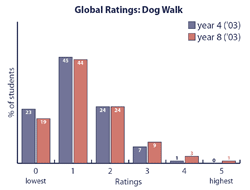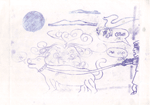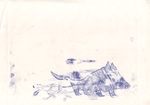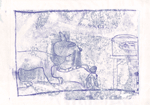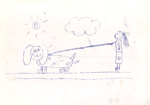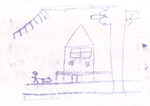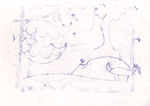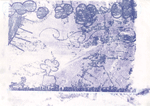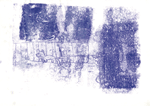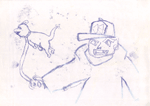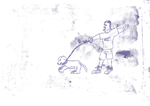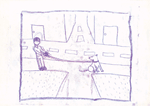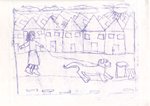|
||||||||||
Arrange
four independent (non-interactive) work spaces, each with its own set
of materials.
Your picture is to be about taking a pet dog for a walk. This is no ordinary walk, because the dog is very very keen – it is very very big – and it is very strong. It is so strong, that it is really taking you for a walk as it pulls you along on the end of the rope. The dog knows where it wants to go – which may not be where you want to go! Its nose is busy as it busily sniffs out smells and the things that interest it – but not you! Try to draw your picture so that it really shows what it would be like to be getting tugged along by this very excited dog. Think about what you will look like and the position of your body. Think about what the dog will look like, and how it is sniffing as it tugs you along. You have about 20 minutes to do this activity. I will let you know when you have used up half of your time.You can make more than one print if you have enough time. The materials you need are on your tables, so you can start now. When half the time is up: Half of the time has been used. There are 10 minutes left for making your pictures. See how much more you can get done in that time. When time is up, ask students to finish off their work.Ask the student to identify the print they think turned out the best. Keep that print for NEMP and allow student to take remaining prints. |
|||||||||||||||||||||||||
| %
responses |
|||||||||||||||||||||||||
|
y4
|
y8 |
||||||||||||||||||||||||
| Key attributes: (0 low – 3 high) | |||||||||||||||||||||||||
expressiveness: image effectively tells a story appropriate to the task; conveys movement; imagination |
0.80 |
0.96 |
|||||||||||||||||||||||
composition:
arrangement of objects in space; balance and depth; relationship of person and dog to environment |
0.81 |
0.98 |
|||||||||||||||||||||||
use
of media: technical control; exploiting a range of mark making; mark making supports expressive focus |
0.99 |
1.06 |
|||||||||||||||||||||||
Global
rating: (0 low – 5 high) |
1.18 |
1.35 |
|||||||||||||||||||||||
| Commentary: The difference between year 4 and year 8 in the mean scores for each of the three attributes of expressiveness, composition and use of media was small, and this was further confirmed in the mean global ratings. 8% of year 4 and 13% of year 8 prints were given marks on the top three points of the six-point global scale. Over half of year 4 and year 8 prints were given marks on the bottom two points of the global scale. While students clearly enjoyed this printmaking task and were able to follow the printmaking procedures demonstrated on video, it was generally apparent that few had much experience or practice in this picture making process. |
|||||||||||||||||||||||||
DOG
WALK EXEMPLARS – [click on pictures to enlarge] |
|||||||||||||||||||||||||
|
|||||||||||||||||||||||||
|
|
|
|

